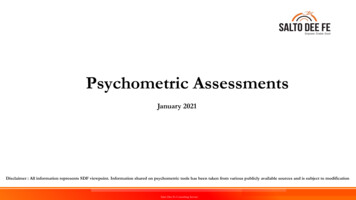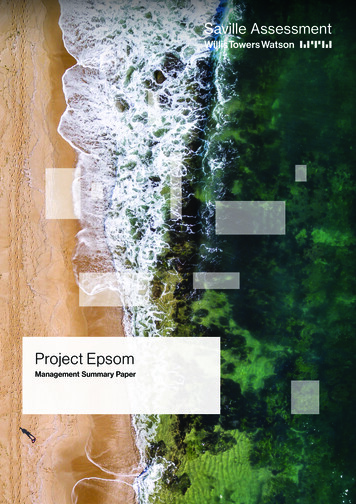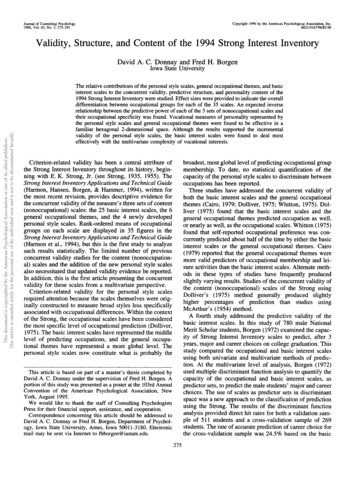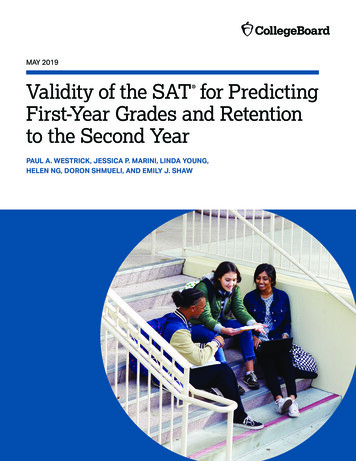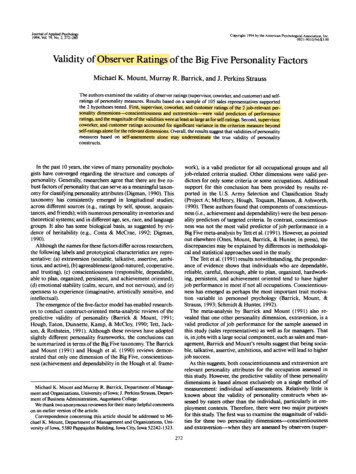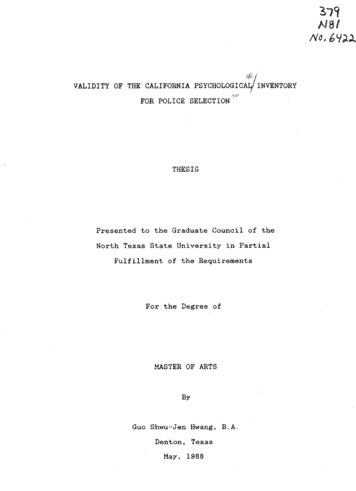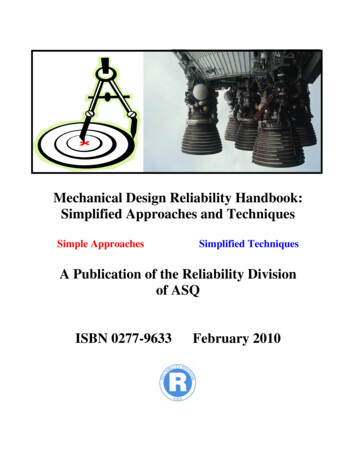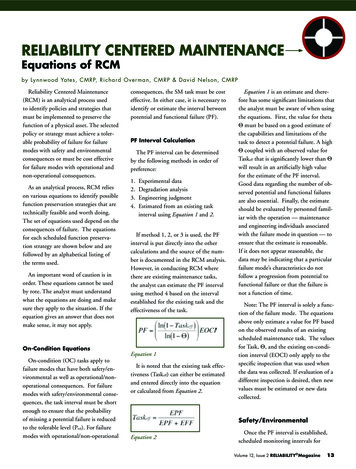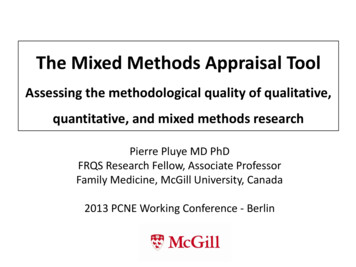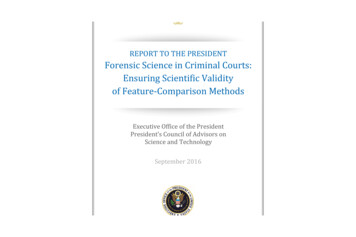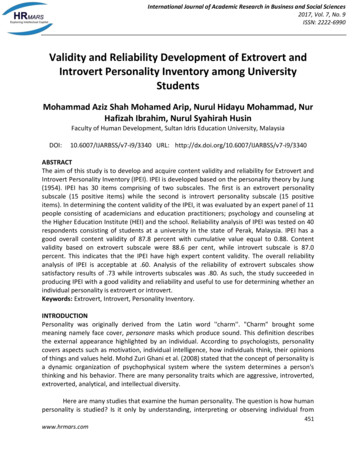
Transcription
International Journal of Academic Research in Business and Social Sciences2017, Vol. 7, No. 9ISSN: 2222-6990Validity and Reliability Development of Extrovert andIntrovert Personality Inventory among UniversityStudentsMohammad Aziz Shah Mohamed Arip, Nurul Hidayu Mohammad, NurHafizah Ibrahim, Nurul Syahirah HusinFaculty of Human Development, Sultan Idris Education University, MalaysiaDOI:10.6007/IJARBSS/v7-i9/3340 URL: CTThe aim of this study is to develop and acquire content validity and reliability for Extrovert andIntrovert Personality Inventory (IPEI). IPEI is developed based on the personality theory by Jung(1954). IPEI has 30 items comprising of two subscales. The first is an extrovert personalitysubscale (15 positive items) while the second is introvert personality subscale (15 positiveitems). In determining the content validity of the IPEI, it was evaluated by an expert panel of 11people consisting of academicians and education practitioners; psychology and counseling atthe Higher Education Institute (HEI) and the school. Reliability analysis of IPEI was tested on 40respondents consisting of students at a university in the state of Perak, Malaysia. IPEI has agood overall content validity of 87.8 percent with cumulative value equal to 0.88. Contentvalidity based on extrovert subscale were 88.6 per cent, while introvert subscale is 87.0percent. This indicates that the IPEI have high expert content validity. The overall reliabilityanalysis of IPEI is acceptable at .60. Analysis of the reliability of extrovert subscales showsatisfactory results of .73 while introverts subscales was .80. As such, the study succeeded inproducing IPEI with a good validity and reliability and useful to use for determining whether anindividual personality is extrovert or introvert.Keywords: Extrovert, Introvert, Personality Inventory.INTRODUCTIONPersonality was originally derived from the Latin word ''charm''. "Charm" brought somemeaning namely face cover, personare masks which produce sound. This definition describesthe external appearance highlighted by an individual. According to psychologists, personalitycovers aspects such as motivation, individual intelligence, how individuals think, their opinionsof things and values held. Mohd Zuri Ghani et al. (2008) stated that the concept of personality isa dynamic organization of psychophysical system where the system determines a person'sthinking and his behavior. There are many personality traits which are aggressive, introverted,extroverted, analytical, and intellectual diversity.Here are many studies that examine the human personality. The question is how humanpersonality is studied? Is it only by understanding, interpreting or observing individual from451www.hrmars.com
International Journal of Academic Research in Business and Social Sciences2017, Vol. 7, No. 9ISSN: 2222-6990external view? As such, Ahmad (2009) stated that the study on the human personality shouldhave focus. The researchers studied the personality by focusing on two key aspects which arehuman differences and the formation of human personality. An understanding of the theory ofpersonality and exploring the uniqueness of the individual is the basis for carrying out researchon personality. Eysenck (2009) describes the development of personality inventory is to helpindividuals clearly recognize the personality based on special measuring tools to measurepersonality.This study focused on two personality traits that are introverts and extroverts.According to Jung (1954), personality can be categorized into two which are extroverts andintroverts. Extrovert individual is a person who does not like the inner world and more focusedon the external world. Extrovert individuals are usually more active and more aggressive. Theyalso love to socialize and often involved in various social activities. Extrovert individuals are alsooptimistic and like change for the better. Even so, an extrovert individual cannot be relied uponbecause they do not like to be bound by the rules or a situation.Meanwhile, introverted individuals are individuals who are less active, emotional, not sotalkative and less social. They would rather do some tasks individually without expecting helpfrom others rather than working in groups. The introverted individual is a serious person, timid,thinking less into the future and dislike to think of the initiative to a problem. They also likedroutine activities and emphasizes on neatness and order. In addition, the introverted individualhas high self-control and stay bound by the rules.Extrovert and Introvert Personality Inventory is developed with reference to thepersonality theory put forward by Jung (1954). IPEI has 30 items comprising of two subscales.Each subscale consists of 15 items which are all positive items. The first subscale is an extrovertpersonality, while the second subscale is introverted personality. The form of responseprovided for each item is the nominal scale with 'YES' or 'NO' options. This inventory wasadministered for a period of 10 to 15 minutes only. The environment whilst answering theinventory should be conducive, comfortable and unobtrusive to the subject. The instructionsgiven should be brief, concise and clear to make it easy for the subject to understand. The timeto answer IPEI is short, without taking a long time to provide an answer for each item.LITERATURE REVIEWThere are several studies conducted on extrovert and introvert personality. Among the studiesconducted by Kalani et al., (2014). The researcher conducted a study to see whether there is arelationship between the personality type of Iranian students studying English ForeignLanguage (EFL) with their pronunciation. Studies have found that there is a significantrelationship between the term EFL students with their personality character. The score on thepronunciation shows the positive relationship with the introvert student compared to theextrovert student. The findings show that the higher the introvert of a person, the better theirpronunciation and their performance in the ESL achievement.452www.hrmars.com
International Journal of Academic Research in Business and Social Sciences2017, Vol. 7, No. 9ISSN: 2222-6990Maria Pappas (2013) has studied the introvert-extrovert dynamics and skills of generalworkers on how to deal with pressure situation. This study has used Jung theory as a theoreticalbasis. The findings show that there is a unique relationship between introvert and extrovertpersonality in the environment and its impact on the skills of the force when depressed. Thestudy also found that socioeconomic status also played a role. Low socioeconomic status ismore likely to cause individuals to undergo certain types of stress and its occur over time.Individuals with introvert tricks are more likely to experience stress than extrovert individuals.Studies also show that the importance of positive environment for introvert and extrovertpersonality.Azlin and Suhaida (2013) conducted a study on the career interests and studentspersonality in the vocational and technical field in Pudu zone, Kuala Lumpur. 364 primaryschool childrens in the Pudu Zone were involved in this study. The study was conducted usingquantitative methods which is distributed questionnaires to the students. The Holland CareerInventory and the Big Five Personality Inventory have been used to measure both variables. Theresults showed that there were no personal differences between male and female students.The results of this study are very similar to the study conducted by Asrul (2010), theoutstanding students possessing high personality traits of Agreeableness, Extraversion,Conscientiousness and Openness as well as a moderate level of Neuroticism traits. In addition,the study also shows a significant relationship between all personality traits of Big Five exceptthe personality traits of Neuroticism.Another study was conducted to study extrovert and introvert personality tricks. Thestudy conducted by Steele and Sylvester (2011) studied the types of professional musicinstructors and music therapist students as well as their comparison with undergraduatestudents based on Myers-Briggs. The study found that music instructors got high scores in theExtrovert-Intuition-Feeling-Assessment while the music therapists got Introvert-IntuitionFeeling-Assessment score. This may be due to maturity factors. In addition, the study alsofound that the difference between them is the introvert and extrovert tricks and how they seetheir life. Overall, it can be concluded that the personality capabilities between musicinstructors and music therapists are almost identical in many aspects.The entire literature study was conducted indirectly as a guide for researchers to designIPE-I inventory based on the findings and validity of the original inventory and this value wasimproved after identifying improvements from previous studies. Based on the findings of thestudy, researchers are increasingly clear that there is still a lack of research related to extrovertand introvert personalities in Malaysia. Hence, the results of the study based on the previousstudy helped to improve the results of the study in controlling the variables in order to achievebetter value and reliability of IPE-I and can be used in diversity of situations.453www.hrmars.com
International Journal of Academic Research in Business and Social Sciences2017, Vol. 7, No. 9ISSN: 2222-6990PROBLEM STATEMENTEveryone has a personality of its own. Personality gives various meanings. Most psychologistsalso have different opinions in describing the definition of personality. But clearly, psychologistuses the word "personality" to show something more than the role an individual play. AhmadAmri (2009) noted personalities as part of the system that produces a behavior. Personality alsorefers to the pattern of permanent traits linked and unique character that are both consistentand provide an overview of a person's behavior individually (Feist, J. & Feist, GJ., 2006). In otherwords, personality is something that represents an individual and always reflect the individualcharacter from the aspects of thoughts, feelings and behavior. Personality can also change andmodified but it requires time and effort.Great scholars in the field of counseling are also talking about the personality ofindividuals. According to Svartberg and Stiles (1991), Freud defines personality as a result of theintegration of the internal structure of the id, ego and superego. Individual personality is alsoviewed as reality and stable to develop the individual self. Eysenck (2009) also clarify thestatement of Rogers's on personality as something that changes and evolves. This is in line withthe self-concept and the potential that exists within the individual that is constantly evolvingand changing according to the situation. It is important for the individual to know andunderstand their own personalities which contribute to the improvement of themselves. As aresult, the field of personality has become an interesting and important field to be studied inorder to find, measure and interpret the various dimensions of human personality.The rapid development of personality measurement occurred during the First WorldWar. There were a lot of personality measurement tools being developed based on thepersonality theories established by various well-known scholars. Chek Mat (2008) suggestedthat a personality test can be divided into objective or projective tests depending on the subjectto be tested. Among the personality assessment that has been developed is Edward PersonalPreferred Schedule (EPPS), Jackson Personality Research Form (PRF), the Myers-Briggs TypesIndicator (MBTI), State Trait Anxiety Inventory (STAI), Cattell Sixteen Personality FactorQuestionnaire (16PF), Eysenck Personality Questionnaire (EPQ), Comrey Personality Scales(CPS), NEO Personality Inventory-Revised (VEO PI-R), Minnesota Multiphasic Personality-2(MMPI-2), the California Psychological Inventory (CPI) and Draw-a-Person (DAP ).This study focuses on the personality of introverts and extroverts even though there area lot of personality traits of an individual. Personality not only refers to the behavior patternsbut also affect a person's character from the point of thinking, feeling, sensing and intuitionwhether visible or hidden. Both introvert and extrovert personality exists within eachindividual. However, only one personality trait is dominant in each individual. All individuals willnot have both high or low extroverted and introverted personality traits. However, theprobability of an individual to have half the introverted personality traits and half extrovertedpersonality trait is high.454www.hrmars.com
International Journal of Academic Research in Business and Social Sciences2017, Vol. 7, No. 9ISSN: 2222-6990The classification of extrovert and introvert personality type performed by Jung is basedon individual relationships or interactions with other people. Individuals who are extrovert canadapt socially and show interest in interacting. Individuals who have introvert characteristicsare not interested in social interaction as they are more inclined to self-reactions. Mahani,Ramlah and Shahabuddin (2003) stated that individuals who dominated either the extrovertedor introverted personality will not affect their self-development as long as they have theawareness to behave properly. This shows that each of the personality that individual has doesnot affect the way people behave and this is considered as the individual uniqueness which isdistinctive and different.Many studies have been conducted to look at the impact of the extroverted andintroverted personality traits. However, these studies were all conducted abroad. The study ofextrovert and introvert personality traits is lacking in Malaysia. If there is, such studies largelyapplied theoretical foundation such as the Five Main Theory and personality theory based onEysenck. In-depth study based on Jung theoretical foundation is limited. Therefore, it is timelyto conduct this study to determine the dominant traits among students whether extroverted orintroverted personality.THEORETICAL FOUNDATION OF THE DEVELOPMENT OF EXTROVERT-INTROVERT PERSONALITYINVENTORYResearchers have applied Jung's theory in the development of this theory. This theory is used asa guide so that the developed items correspond with the features contained in the subscale.Jung (1954) submitted a psychiatric theory that explains the theory of extroverts and introverts.Jung interprets extrovert as an attitude influenced by the outside world, other people andmaterial. Introvert is an individual living conditions which are influenced by his action andreaction to his own world, thought, intuition, emotions, and feelings. Each individual usually hasboth types of the attitude. Individuals will tend to have an introvert or extrovert attitude.Extroverted personality can be deeply understood as someone who is comfortable andlike to interact with others. They are usually happy to communicate with others, passionate,enjoy activities that involve a lot of people such as party, community and political activities.Extroverted individuals are suitable in fields such as politics, teaching, sales and management.Tired of being alone are among the characteristics of an extrovert. Extroverted individuals tendto be positive in his life, but this does not mean that an introvert is not thinking positively. Inbehavior, people with extrovert characteristics usually dress for comfort and simple looks. Theydo not have a problem with noisy situations. Extroverted individuals easily start a conversationwith other people. The studies which have been carried out states that extroverted individualstend to feel happiness and have more confidence than introverted individuals. However, thisstudy is biased because we cannot easily determine a person's happiness.An introvert tends to be solitary and less prominent in group activities. They usually likeactivities such as reading, writing, hiking, and fishing. A writer, composer, engineer and painter455www.hrmars.com
International Journal of Academic Research in Business and Social Sciences2017, Vol. 7, No. 9ISSN: 2222-6990is introverted individual. They usually like solitary activity and happy to have just close friends.Always think before speaking and acting, being quiet is also a characteristic of an introvert.Introverted individuals are more emotional because parts of the brain that regulate emotionwhich are the cingulate gyrus and the posterior (rear) thalamus have more blood flow. Inbehavior, introverted person like more artistic clothing. One interesting study noted thatintroverted individuals produce more saliva when looking at lemon juice drink. Happiness ofintroverted individual is usually neutral. Many are associating an introvert with a smart, geniusand gifted individual.RESEARCH METHODSThe study design was a descriptive study that aims to get the validity and reliability of IPEI. Thestudy involved three phases namely Phase 1: Development of IPEI, Phase 2: Content Validity ofIPEI, and Phase 3: Reliability Analysis of IPEI.Phase 1: Development of IPEIThe development of IPEI is accomplished through library research involving previous studiesand theoretical approaches that are appropriate based on individual personalities. Individualpersonality can generally be divided into two parts, extrovert and introvert personalities.Individuals can be distinguished by two personalities which are extrovert and introvertpersonalities. Individuals tend to show their dominant personality in order to adapt to theirenvironment. Individuals will put themselves in the environment through a variety of ways tosocialize, talk, behave, act, respond to and receive information from others.Phase 2: Obtaining Content Validity of IPEIThe measurement of the concept is considered as an authentic measure when it managed tomeasure it in scientific terms. According to Azizi et al. (2006), the instrument used formeasurement is important because it functions as an early indicator so that researchers canmeasure what is to be measured accurately and validly. He explains further that validity refersto the meaningful and useful things which are concluded from the test scores. Validity is animportant concept in the context of the measurement of constructs or ideas such as attitude,motivation, perception, fitness and achievement.The IPEI content validity was obtained by asking the views of 11 experts, fiveprofessionals in the field of counseling and six practitioners in the field of counseling. All of theexperts have been selected based on the knowledge and practice of counseling they received.The researchers first prepare a letter of authorization to carry out the validity analysis. Thevalidity is obtained through a process where the experts are required to mark the inventoryaccording to the given selection scales of 1 to 10. Scale 1 represents strongly disagree whilescale 10 represents strongly agree.456www.hrmars.com
International Journal of Academic Research in Business and Social Sciences2017, Vol. 7, No. 9ISSN: 2222-6990Phase 3: Reliability Analysis of IPEIThe third phase was carried out with the aim of obtaining the reliability scores of IPEI.According to Sazali (2009), reliability means the ability of a measuring instrument to measurethe phenomenon accurately and consistently so that different interpretation of the instrumentsby the respondents will not arise. The reliability obtained for the inventory was derived fromover 40 students at a university in the state of Perak. The samples were selected using a simplerandom sampling method. The data were analyzed using SPSS to obtain the Cronbach Alphavalue in order to assess the reliability of the IPEI.Subjects and Place of studyThe subjects of study were only involved in the second and third phases of the study. In thesecond phase of the study, the subjects were 11 panel of experts consisting of academicians inhigher education institutions and practitioners in psychology and counseling in schools andinstitutions of higher learning. While in the third phase, a total of 40 students from a universityin the state of Perak, Malaysia, were randomly selected to obtain IPEI reliability data.Research InstrumentThe research instrument used is Extrovert and Introvert Personality Inventory (IPEI) whichcontains 30 items consisting of two subscales. The first subscale is an extroverted personality(15 positive items) while the second subscale is the introverted personality (15 positive items).RESEARCH FINDINGSPhase 1 research findings: Development of scale, sub scale and item inventoryThe development of IPEI Survey was conducted based on library research and in-depth previousstudies and corresponding theoretical approach has been the basis for the development of IPEI.Based on in-depth previous studies, the appropriate theoretical approach as the basis for thedevelopment of IPEI is Carl Jung's Personality Theory. This theory is clearly and distinctlyformulated on the two main personalities that will dominate an individual.The development of IPEI is based on theoretical background and its basis. Based on therecommendation made by the researchers, the developed IPEI contains 30 positive items and isdivided into two subscales which is extrovert (15 items) and introvert (15 items).Phase 2 research findings: Content validity valueBased on the agreement of expert panel, the IPEI value is as shown in Table 1:457www.hrmars.com
International Journal of Academic Research in Business and Social Sciences2017, Vol. 7, No. 9ISSN: 2222-6990Scale / Sub-scaleOverall IPEIExtrovertIntrovertTABLE 1Overall and Sub Scale Validity Value of IPEI (N 11)Item No.301515Value8.788.868.70Table 1 shows the overall validity of the IPEI is 8.78 (87.8%). While the highest content validityis 8.86 (88.6%) of the extrovert sub-scale and the lowest is introvert subscale with 8.7 (87%).This indicates that the IPEI has high expert content validity.Phase 3 research findings: Reliability Value of Items in IPEIIPEI reliability analysis are shown in Table 2 below:TABLE 2Overall Scale and Sub Scale Reliability Analysis of IPEI (N 40)Scale / Sub-scaleOverall IPEIExtrovertIntrovertItem No.Cronbach Alpha301515.60.73.80The IPEI reliability analysis shows that the Cronbach Alpha coefficients is at acceptablevalue of .60. This shows the IPEI has good internal reliability and proves that IPEI can clearlymeasure the individual personality. The IPEI reliability by sub-scale scores is also good wherethe extrovert reliability is .73 and .80 for Introverts. This indicates that these items are goodand acceptable to conduct a study.Next, based on Table 2 is the reliability analysis to test the quality level of the developedpositive items. For IPEI, sub-scale item of 1-15 is for the extrovert, while 16-30 is for Introvertsub-scale. The results obtained are as follows:458www.hrmars.com
International Journal of Academic Research in Business and Social Sciences2017, Vol. 7, No. 9ISSN: 2222-6990TABLE 3IPEI’s Reliability for Each ItemsNo. 19.20.21.22.23.24.25.26.27.28.29.30.I'm a friendly personI love outdoors activitiesI love to start a conversation if I meet new peopleI love to attend gatherings and partiesI love to give my views in a discussionI have many close friendsI love a festive atmosphereI like to get involved in volunteering activitiesI'm comfortable when being in a crowded groupI like to joke with friendsI'm comfortable when many guests come to my houseI like to eat togetherI like to help even though they are strangersI really appreciate the time together with people around meI am a jolly personI'm more comfortable playing with pets than talking to peoplearound meI like to eat aloneI love to calm my mind in a quiet environmentI am a quiet personI like to be aloneI rarely mingle with family membersI do not like to talk about myselfI prefer to indulge on my own feelings rather than talkI do not like to mingleI am stressed in a noisy environmentI do not have many friendsI easily get bored when I am in publicI listened more than talkedI'm happy when aloneI do not like exercising with .56.58.54.58Table 3 shows the lowest reliability value of .54 for item number 21 and 29 under theIntrovert sub-scale. While the highest reliability is at .63, for item number 6 under the Extrovertsub-scale. The reliability value of medium-high for each item indicates the quality of the itemsthat are developed at an appropriate level, can be understood and accepted by the respondent.Valette (1997) also stated that the reliability coefficient of .50 or more is acceptable. This is in459www.hrmars.com
International Journal of Academic Research in Business and Social Sciences2017, Vol. 7, No. 9ISSN: 2222-6990line with the opinion expressed by Mohd Majid Konting (1990), who states that the value ofreliability coefficient of 0.60 or more is good and acceptable.DISCUSSIONThis study could provide useful implications to the field of psychology, counseling and thecommunity in Malaysia in terms of recognizing own personality. There are various personalitytests developed to help individuals in recognizing their dominant personality. This is becausepersonality plays a key role in the efforts to develop the potential of the individual. Individualswho are clear on their personality can contribute to their self-development in career selection,learning process, adapting to the environment and interpersonal relationships.The strengths and weaknesses of both extroverted and introverted personality can beseen through the developed items. It does not aim to show the comparison between the twopersonalities, but focused more on the individuals’ awareness about their personality.According to Feist and Feist (2006), every individual has both extroverted and introvertedpersonality although either one of these will be the dominant personality of the individual. Thepersonality that dominates an individual does not fully reflect the individual who ischaracterized as an extrovert base on the level of extrovert of the individual. Likewise, thedominant introverted personality of the individual does not mean that the individual does nothave extroverted characteristics.Based on the analysis done on both extrovert and introvert subscales, the validity andreliability value is at an acceptable value and is used to help individuals recognize their ownpersonality traits. Jung (1968) indicated that both extroverted and introverted personality hasits own unique function within the individual based on four key aspects of thinking, feeling,sensing and intuition. Friedman and Schustack (2012) described the main functionality of theindividual in recognizing personality as it helps identify the individual in terms of motivation toachieve something. As a result, individuals can assess their own personality through theawareness of self-improvement and self-congruence to develop an attractive personality.The development of IPEI inventory provides added value to individuals who want toknow whether they have extroverted or introverted personality. Each developed item canprovide a definition and understanding for the respondent to make an analysis about them interms of thoughts, feelings, behavior, communication and personality. According to Chek Mat(2008), the personality measurement can be seen to provide a clear understanding of howindividuals want to know their personality and thus are aware of things that are appropriate totheir own personality. As a result, personality measurement tool is important in helpingindividuals to recognize and understand their personalities and provide useful input in theaspect of self-development.The IPEI inventory ability to measure personality is not only important in developing thefield of psychology and counseling, this effort is to look at the individual potential, especially in460www.hrmars.com
International Journal of Academic Research in Business and Social Sciences2017, Vol. 7, No. 9ISSN: 2222-6990the fields of education and career development. This is because, the individual’s personality issignificant in making suitable career choices by looking at the overall working environment thatsuits the individual personality type. This is explained by Nor Azman (2012) on the extrovertedand introverted personality in terms of the career inclination in which both personality typeswill affect the individual decision in choosing a career. The quality of work among governmentor private employees can be increased based on their personality suitability with the job whichhelps individuals to increase efficiency in the field of work they undertake.The IPEI inventory ability to measure personality is not only important in developing thefield of psychology and counseling, this effort is to look at the individual potential, especially inthe fields of education and career development. This is because, the individual’s personality issignificant in making suitable career choices by looking at the overall working environment thatsuits the individual personality type. This is explained by Nor Azman (2012) on the extrovertedand introverted personality in terms of the career inclination in which both personality typeswill affect the individual decision in choosing a career. The quality of work among governmentor private employees can be increased based on their personality suitability with the job whichhelps individuals to increase efficiency in the field of work they undertake.Based on the research findings which obtained high validity and reliability of the IPEI,the researchers recommended that the IPEI be used and implemented in a m
Among the personality assessment that has been developed is Edward Personal . Questionnaire (16PF), Eysenck Personality Questionnaire (EPQ), Comrey Personality Scales (CPS), NEO Personality Inventory-Revised (VEO PI-R), Minnesota Multiphasic Personality-2 (MMPI-2), the California Psychological Inventory (CPI) and Draw-a-Person (DAP ). .
